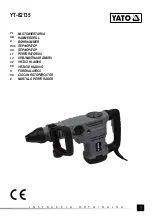
14
GB
O R I G I N A L I N S T R U C T I O N S
Drilling with hammer action is recommended only in case of compact ceramic materials: concrete, hard bricks, stone etc. In case
of drilling holes of large diameter, it is recommended to drill first a smaller guide hole, and then use a drill of the final diameter. Use
drills designed for hammer action drilling.
It is not recommended to use the hammer action function in case of ceramic materials of loose structure, such as: glaze, soft
bricks, plaster, etc. Hammer action drilling in such materials may damage the material.
The hammer drill is equipped with a clutch that prevents overloading of the electric motor in case when the tool is jammed during
work, for example as a result of hitting a reinforcement wire. In such cases the drill will stop rotating, although the electric motor
is still working.
Also excessive pressure exerted on the tool during work may cause activation of the clutch.
In such cases remove the tool from the hole, make sure the hammer drill is functioning correctly and then resume work, applying
only the pressure which is necessary for proper operation. In case a reinforcement rod or another hidden metal obstacle is hit,
drill it using the hammer action function and a drill for metal of the same diameter as the hammer action drill, and then continue
drilling in the ceramic material.
Adjustments of the angle of the chisel
Certain hammering tools require adjustments to a certain angle, in order to guarantee a safe and ergonomic operation, for exam-
ple chisels and cutters. It is possible to use for this purpose an adequate operating mode selector. Install the tool in the chuck in
accordance with the recommendations indicated in the manual. Set the selector to the hammer symbol with an arrow, and then
press the switch. The tool will start to rotate in accordance with the selected direction of rotation. Release the switch, once the
tool has reached the required position. Set the operating mode selector to the hammering position – hammer symbol, and then
start work.
Hammering
While the tool is disconnected from the mains install the required tool in the chuck: cutter or punch.
Set the operating mode selector to the hammering position. Plug the drill to the mains, turn the hammer drill on with the switch,
wait until it has reached the full speed and start work.
During hammering, do not drive the tool too much into the material to be processed. Hack the material off in thin layers, not exert-
ing excessive pressure on the hammer drill.
Protection of the drilling chuck
If the hammer drill is equipped with a rubber protection of the chuck, then it is recommended to use it in case of drilling with the
drill pointing up, e.g. for drilling in ceilings. Once the drill has been installed in the chuck, place the protection on it. Dust and debris
generated during drilling will accumulate in the protection, which permits to keep the chuck clean. Once work has ended, remove
the protection from the drill, remove dust and debris from the protection, and then rinse it under lukewarm water.
Additional remarks
During work do not exert excessive pressure on the material to be processed and do not make abrupt movements, so as not to
damage the tool and the drill. Make regular breaks during work. Avoid overloading the tool. The temperature of the external sur-
faces must not exceed 60
O
C. Once work has been finished, turn the drill off, unplug it from the mains and proceed to maintenance
and inspection.
The declared total value of vibrations has been determined by means of a standard method and it may be used for comparative
purposes. The declared total value of vibrations may be applied in the preliminary assessment of exposure.
Attention! The emission of vibrations during work with the tool may differ from the declared value, depending on the use of the
tool.
Attention! It is required to determine safety means to protect the operator, which are based on assessment of exposure under
real operating conditions (including the whole working cycle, as for example the time when the tool is of or idling, and the time of
activation).
Lubrication
Before each use of drills or cutters they must be thoroughly cleaned and the SDS max chuck must be lubricated with a thin layer
of grease. It is recommended to use grease designed for the SDS max chucks. In case of incorrect operation of the hammer
action mechanism, one of the reasons may be incorrect lubrication of the gear and the crank assembly of the hammer action
piston. It is recommended to use grease designed for toothed and crank gears. It is recommended to have grease refilled in an
authorised service point.
MAINTENANCE AND OVERHAUL
ATTENTION! Before any adjustment, technical service or maintenance operations unplug the tool. Once the operations have been
finished, the technical conditions of the tool must be assessed by means of external evaluation and inspection of the following
elements: body and handle, conductor with a plug and deflection, functioning of the electric switch, patency of ventilation slots,
Содержание YT-82135
Страница 22: ...22 RUS...
Страница 23: ...23 RUS III SDS max SDS max SDS max IV SDS max V V...
Страница 24: ...24 RUS VI...
Страница 25: ...25 RUS 60 o C SDS max SDS max 0 3 MPa...
Страница 27: ...27 UA...
Страница 28: ...28 UA III SDS max SDS max SDS max IV SDS max V V VI...
Страница 29: ...29 UA 60o C...
Страница 30: ...30 UA SDS max SDS max 0 3 MPa...
Страница 68: ...I N S T R U K C J A O R Y G I N A L N A 68...















































